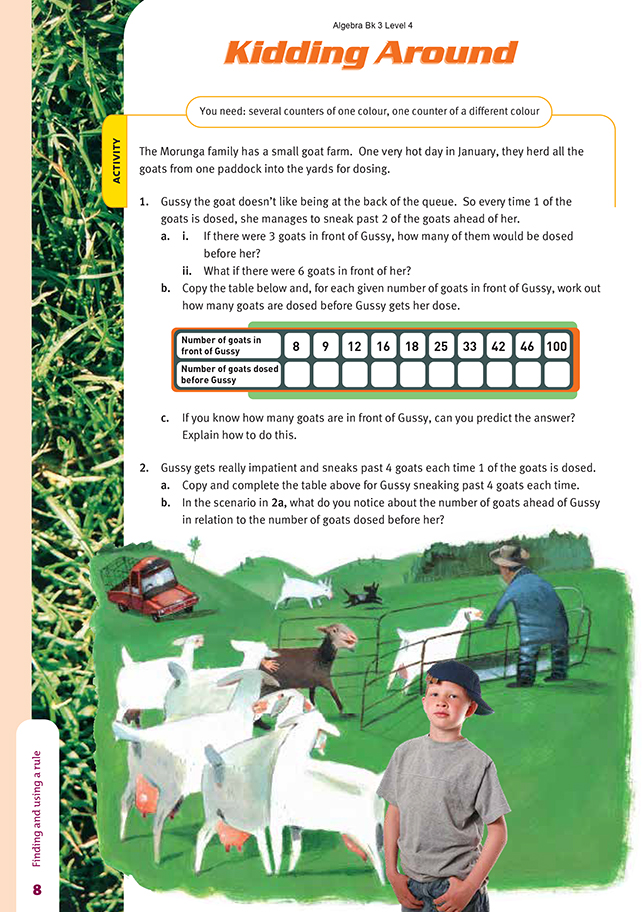This is a level 4 algebra strand activity from the Figure It Out series.
A PDF of the student activity is included.
Click on the image to enlarge it. Click again to close. Download PDF (239 KB)
use a table to find a rule
use a rule to describe a relationship
several counters of different colours
one counter of a different colour
FIO, Level 4, Algebra, Book Three, Kidding Around, page 8
In this activity, students work to identify patterns based on groupings of a particular size.
The students will probably need to systematically explore this problem using counters to represent goats. The counter for Gussy should be a different colour from the counters for the other goats. The students should check what happens when there is 1 goat ahead of Gussy, then 2, then 3, and so on, up to at least 13 goats ahead of Gussy. In the diagrams below, Gussy is the shaded counter..gif)
Notice that Gussy reaches the head of the queue after just 1 goat is dosed regardless of whether there are 1, 2, or 3 goats ahead of her. When there are 4 goats ahead of her, 2 goats will be dosed before Gussy reaches the head of the queue..gif)
In fact, this is the outcome whether there are 4, 5, or 6 undosed goats ahead of her.
The following table shows what happens when there are 1, 2, 3, … undosed goats in front of Gussy:
.gif)
As noted in the Answers, when the number of goats in front of Gussy is a multiple of 3 (shaded rows in the table), the number of goats dosed before Gussy is the number of undosed goats in front of Gussy divided by 3. So, for example, when there are 18 undosed goats ahead of Gussy, the number of goats dosed before Gussy is
18 ÷ 3 = 6.
When the number of undosed goats in front of Gussy is not a multiple of 3, round that number up to the next multiple of 3 and divide the rounded number by 3. So, for example, when there are 16 undosed goats ahead of Gussy, first round 16 up to 18. Then the number of goats dosed before Gussy is 18 ÷ 3 = 6. When there are 100 undosed goats ahead of Gussy, round 100 to 102 because 100 is not a multiple
of 3 and 102 is the first multiple of 3 after 100. Then the number of goats dosed before Gussy is 102 ÷ 3 = 34.
The following table shows what happens when Gussy sneaks past 4 goats ahead of her instead of 2, each time a goat is dosed:
.gif)
Here, the number of goats dosed before Gussy changes immediately after each multiple of 5 rather than after each multiple of 3 as earlier. The students may be puzzled that we look at multiples of 3 and 5 when the number of goats that Gussy is sneaking past is 2 and 4 respectively. The reason for doing this is clear once we realise that whenever Gussy sneaks past 2 (or 4) goats, another goat is being
dosed, so that really we need to consider the goats in groups of 3 (or 5).
Students who manage to reason this outcome may like to see if they can generalise the results when Gussy sneaks past 5, 6, … 100 undosed goats ahead of her. In fact, when Gussy sneaks past any number, x, of undosed goats ahead of her, the number of goats dosed before Gussy changes immediately after each multiple of
x + 1 undosed goats ahead of her.
Answers to Activity
1. a. i. 1 goat
ii. 2 goats would be dosed before Gussy.
b.
.gif)
c. If the number of goats in front of Gussy is a multiple of 3, you divide that number by 3 to find the number of goats dosed before Gussy. If the number of goats in front of Gussy is not a multiple of 3, you round that number to the next multiple of 3 and divide by 3. For example, for 10, 11, or 12 goats in front of Gussy at the start,
Gussy would have to wait for 12 ÷ 3 = 4 goats to be dosed.
2a.
.gif)
b. If the number of goats in front of Gussy is a multiple of 5, you divide that number by 5 to find the number of goats dosed before Gussy. If the number of goats in front of Gussy is not a multiple of 5, you round that number to the next multiple of 5 and divide by 5.
